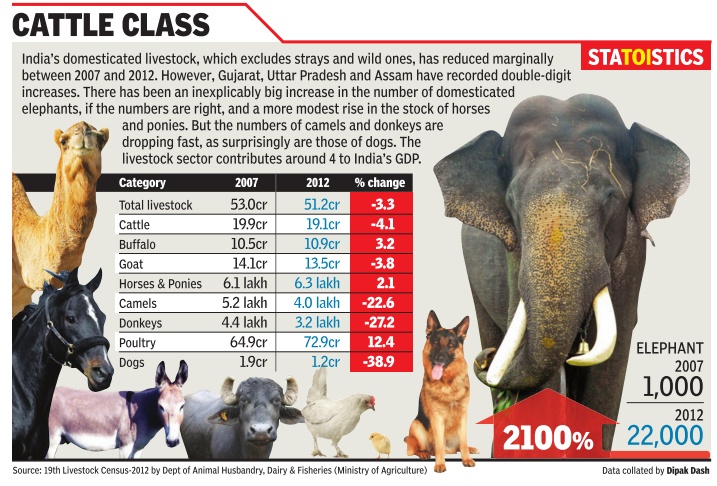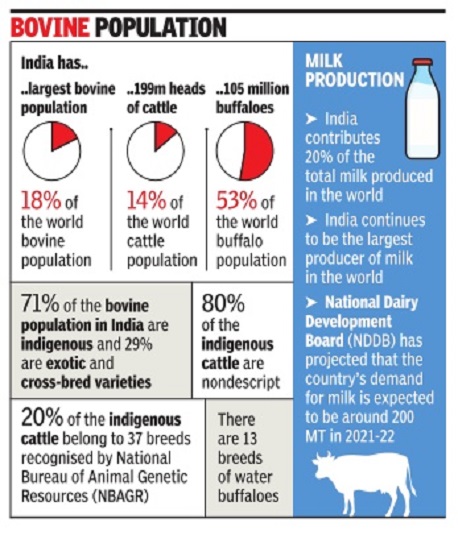Cattle: India
Contents |
Indian cattle in 1911
This section was written around 1911 when conditions were Readers will be able to edit existing articles and post new articles |
Extracted from:
Encyclopaedia of India
1911.
No further details are available about this book, except that it was sponsored in some way by the (British-run) Government of India.
NOTE: While reading please keep in mind that all articles in this series have been scanned from a book. Therefore, footnotes have got inserted into the main text of the article, interrupting the flow. Readers who spot these footnotes gone astray might like to shift them to the correct place.
Secondly, kindly ignore all references to page numbers, because they refer to the physical, printed book.
Throughout the whole of India, except in Sind and the western districts of the Punjab, horned cattle are the only beasts used for ploughing. The well-known humped species of cattle predominates everywhere, being divided into many varieties. Owing partly to unfavourable conditions of climate and soil, partly to the insufficiency of grazing ground, and partly to the want of selection in breeding, the general condition of the cattle is miserably poor. As cultivation advances, the area of waste land available for grazing steadily diminishes, and the prospects of the poor beasts are becoming worse rather than better. Their only hope lies in the introduction of fodder crops as a regular stage in the agricultural course. There are, however, some fine breeds in existence. In Mysore the amrit mahal, a breed said to have been introduced by Hyder Ali for military purposes, is still kept up by the state. In the Madras districts of Nellore and Kurnool the indigenous breed has been greatly improved under the stimulus of cattle shows and prizes founded by British officials. In the Central Provinces there is a peculiar breed of trotting bullocks which is in great demand for wheeled carriages.
The large and handsome oxen of Gujarat in Bombay and of Hariana in the Punjab are excellently adapted for drawing heavy loads in a sandy soil. The fodder famines that accompanied the great famines of 1897 and 1900 proved little short of disastrous to the cattle in the affected provinces. In Gujarat and the arid plains of the south-east Punjab the renowned herds almost disappeared. In the affected districts of the Punjab the loss of cattle averaged from 17 to 45% of the whole. In Rajputana more than half of its thirteen or fourteen millions of stock is said to have perished in 1900 alone. In one state the loss amounted to 90%, and in four others to 70%. In Gujarat half of its 12 million cattle perished in spite of the utmost efforts to obtain fodder.
The worst cattle are to be found always in the deltaic tracts, but there their place is to a large extent taken by buffaloes. These last are more hardy than ordinary cattle; their charactot is maintained by crossing the cows with wild bulls, and their milk yields the best ghi or clarified butter. Along the valley of the Indus, and in the sandy desert which stretches into Rajputana, camels supersede cattle for agricultural operations. The breed of horses has generally deteriorated since the demand for military purposes has declined with the establishment of British supremacy. In Bengal Proper, and also in Madras, it may be broadly said that horses are not bred. But horses are still required for the Indian army, the native cavalry, and the police; and in order to maintain the supply of remounts a civil veterinary department was founded in 1892, transferred in 1903 to the army remount department. Horse-breeding is carried on chiefly in the Punjab, the United Provinces, and Baluchistan, and government keep a number of stallions in the various provinces. Formerly Norfolk trotters held the first place in point of number, but their place has been taken in recent years by English thoroughbreds, Arabs, and especially Australians. For the supply of ordnance, baggage, and transport mules a large number of donkey stallions have been imported by the government annually from various European and other sources. But the supply of suitable animals is not good, and their cost is large; so the breeding of donkey stallions has been undertaken at the Hissar farm in the Punjab.
Domesticated livestock in India
See graphic.

Cow dung
Amreli (Gujarat) places limits on how much cattle can excrete
Cong-ruled Guj civic body puts cap on cow excretion, Dec 03 2016 : The Times of India
How much dung should a cow or buffalo excrete daily? For most, the question is irrelevant but not for the Congress-ruled Amreli municipality, which has clamped restrictions on defecation by cattle on public roads.
In a strange order issued on December 1, the civic body has set a daily lim it of 3 kg for an adult bovine and 1 kg for calves to ex crete dung that too at the specific spots earmarked for them. What's more, the cattle owners who fail to keep a check on quantity of their animals' excreta will be subjected to a humiliating punishment -they will be paraded on donkey in the town, the order stated.
Interestingly, a special flying squad will be constituted to measure the size and weight of the cattle dung.
“We have invited opinion of citizens in this regard and we will publish them in coming days,“ Alka Gondalia, president, Amreli municipality told TOI.
Cattle semen, frozen
2016: available online
Catlle/ bovine population and milk production in India, 2016 Vishwa Mohan, Sale of cattle and their semen gets a digital boost, Nov 28 2016 : The Times of India
Sale of cattle, buffaloes and their frozen semen has gone digital in India. The agriculture ministry on the occasion of the National Milk Day launched a web portal in Nov 2016 which on its very first day saw sales of nearly 9 lakh doses of frozen semen.
The first of its kind of portal in India -http:www.epashuhaat.gov.in -provides a digital market platform to breeders, sellers and buyers.It facilitates trade of live cowsbuffaloes, frozen semen and embryos under a verified and certified system without intervention of middlemen.
“Breedersfarmers can sell and purchase breeding stock through the portal. Information on all forms of germ-plasm including semen, embryos and live animals with all the agencies and stakeholders in the country have been uploaded on the portal“, said the Union agriculture minister Radha Mohan Singh after launching e-pashuhaat.
He noted that the portal will lead to propagation of high genetic merit germplasm. “Farmers would get information on availability of quality disease free bovine germ-plasm in the country at one platform,“ said Singh.
The portal also provides e-transactions and home delivery facility. It not only carries breed and yield details of animals but also enlists their price tag.
Over 5,400 live cattles buffaloes, 1.65 crore doses of frozen semen and 354 embryos were available for trade on the website on the first day . The portal has connected farmers to 56 semen stations across 20 states in the country . Besides being a buyerseller platform, this government portal will also provide many related services to farmers and breeders.
These services include handling of artificial insemination, good care practices, animal certification, nutritional advisory and disease screening and testing of animals.
The portal is part of the ministry's initiative to meet the ever growing demand of milk in the country under a new scheme – National Mission on Bovine Productivity -with an allocation of Rs 825 crore. It is also aimed at making milk production more remunerative to farmers.
“The need to have an integrated market in the form of e-platform was felt because the country , at present, does not have any authentic organised market place for buyingselling animals.“
Though indigenous breeds are currently being sold in local `haats' and animal fairs in different part of the country , it does not guarantee any breed in absence of a verification mechanism“, said an official.
He said, “The farmers are also cheated due to lack of traceability and tracking of particular breeds, frozen semen and embryos. The ministry's portal will, however, now help the buyers in getting authentic breeds of animals and their scientifically verified semen and embryos“.
The Frieswal breed
Military farms' shutdown hits the project
Sandeep Rai, Military farms' shutdown to hit Rs 800cr project, August 8, 2017: The Times of India
A 30-year-long project that cost Rs 800 crore and produced a high-yield breed of cow that, according to experts, contributed to making India self-sufficient in milk production is on the verge of being derailed due to the impending shutdown of military farms across the country.
The Frieswal breed, developed by cross-breeding the Holstein Friesian cow of the Netherlands with the Sahiwal of India, is the result of studies at the Indian Council of Agricultural Research's (ICAR) Central Institute for Research on Cattle (CIRC), located on a military farm here. These farms today house 15,000 such cows and 10,000 bulls and calves and have helped farmers breed hundreds of thousands of the cows over the years. The cows at the farms provide 1 lakh litres of high-quality milk every day , mostly consumed by armed forces personnel.
B Prakash, director, ICAR and head, CIRC, said, “In order to provide more quality milk for the armed forces and the general public, a massive cross-breeding programme was initiated at Meerut in 1987 as a result of an agreement between the defence ministry and ICAR. Land was to be provided by the defence ministry at military farms, while technical expertise was provided by ICAR. After intense research and expenditure of close to Rs 800 crore, the Frieswal breed was developed. It had 62.5% genetic strain of Holstein Friesian and 37.5% of Sahiwal.“
However, now the scien tists involved in the project are a disappointed lot.
“The defence ministry has decided to shut down military farms because the Army is incurring losses while maintaining them. With no other land available to ICAR, the Frieswal project will also be scrapped,“ added Prakash.
According to officials at CIRC, last-ditch efforts are on to shift the centre elsewhere.“The deadline for the closure of these farms is August 15 while the cattle can be disposed of within three months by auction in the open market,“ said Ravindra Sangwan, senior scientist, animal genetics breeding of CIRC.
